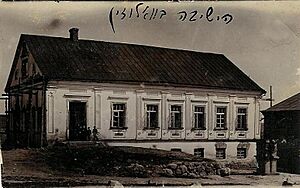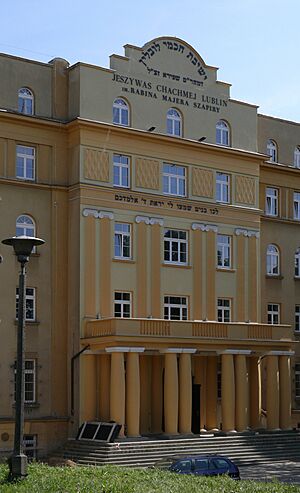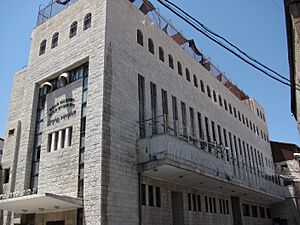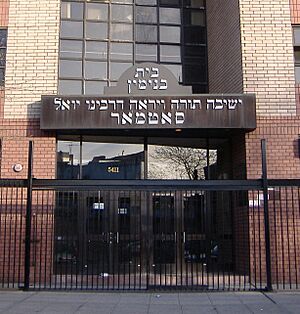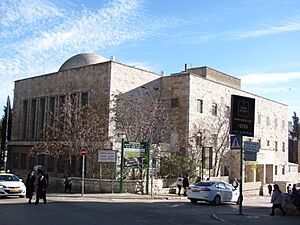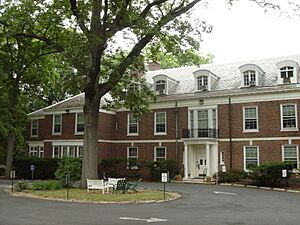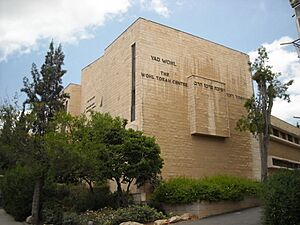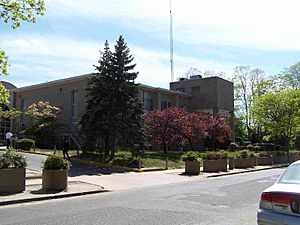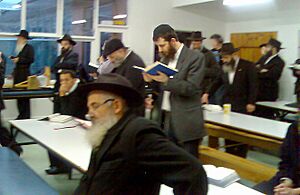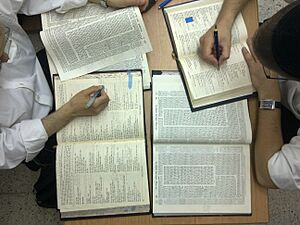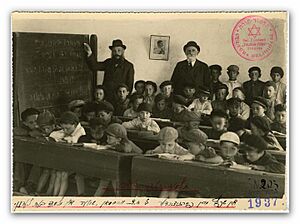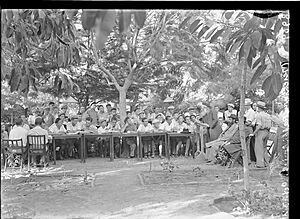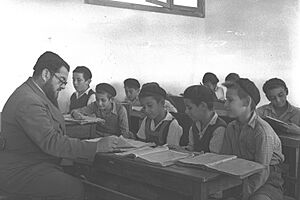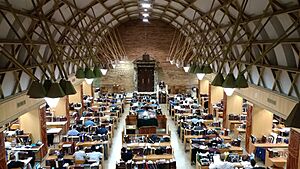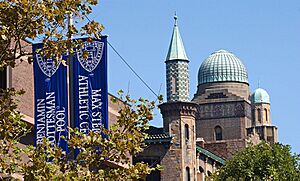Yeshiva facts for kids
A yeshiva (pronounced yeh-shee-vah) is a special Jewish school where students focus on learning about Jewish texts and laws. The main things they study are the Talmud (a big collection of Jewish discussions and laws) and halacha (Jewish law). They also learn about the Torah and Jewish ideas.
Learning in a yeshiva often happens in two ways:
- Shiurim: These are like classes or lectures given by a rabbi.
- Chavrusas: This is a unique way of learning where two students study together as partners. They read the texts, discuss them, and help each other understand. This helps them think deeply and explain their ideas clearly.
In places like the United States and Israel, yeshiva education has different names for different age groups.
- Younger kids (elementary school) might go to a cheder or Talmud Torah.
- After their Bar Mitzvah, students might go to a mesivta (in the U.S.) or a yeshiva ketana (in Israel).
- Older students (like college age) attend a beit midrash or yeshiva gedola (meaning 'large yeshiva').
- A kollel is a yeshiva specifically for married men who want to continue their studies.
Historically, yeshivas were only for boys and men. Today, many non-Orthodox yeshivas welcome both men and women. For Orthodox women and girls, there are separate schools called midrasha or "seminary," which have a different focus and curriculum.
Contents
What Does "Yeshiva" Mean?
The word yeshiva comes from a Hebrew word meaning "sitting." It refers to a learning session or a place where people sit and learn. Other names for these schools include Talmudical academy or rabbinical school. The idea of the name changing from a "learning session" to the "school itself" happened a long time ago, during the time of the famous Talmudic Academies in Babylonia like Sura and Pumbedita.
A Look at Yeshiva History
Early Beginnings
Ancient Jewish texts, like the Mishnah, talk about how important it was for towns to support scholars. For example, a town was considered a "city" if it had ten men who could always be available for communal prayers. Also, Jewish courts often had many students learning from them. People would even take time off work, usually two months a year, just to study.
The Geonic Period (3rd to 13th Century)
This period is named after the "Geonim," who were the leaders of the main yeshivas. These leaders were like principals of their schools and also important spiritual guides and judges for Jewish communities. There were three main yeshivas: in Jerusalem, Sura, and Pumbedita. Even when they moved to new cities like Cairo or Baghdad, they kept their original names.
Jewish communities would choose one of these yeshivas to follow for guidance on Jewish law. The yeshivas were the highest places for Jewish education and for interpreting Jewish law. They also helped manage communities by appointing local leaders. These local leaders would ask the yeshiva for final decisions on religious matters.
Yeshivas were supported by donations from communities and individuals. Sadly, the yeshiva in Jerusalem was forced to move to Cairo and eventually closed. The yeshivas of Sura and Pumbedita also closed after invasions in the 13th century. After this, learning Jewish religious studies became the responsibility of local synagogues.
From the Geonic Period to the 19th Century
After the Geonic period, more yeshivas were started in Europe and North Africa. For example, the Kairuan yeshiva was founded in Tunisia in 974.
Traditionally, every town's rabbi would teach a few students in the town's study hall, usually next to the synagogue. The community helped pay for the students' living costs. After some years, students who received semikha (rabbinical ordination, meaning they became rabbis) would either become rabbis in other towns or join the workforce.
Lithuanian Yeshivas
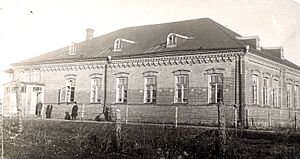
A very important change in Jewish study happened with Chaim Volozhin in the 18th century. He felt that the old way of learning wasn't enough for students who wanted to study more intensely. With his teacher's support, Volozhin started a yeshiva in Valozhyn, which is now in Belarus. This school, the Volozhin yeshiva, was very influential. It closed in 1892 because the Russian government wanted it to teach secular (non-religious) subjects. After that, many other yeshivas opened, like those in Slabodka, Panevėžys, Mir, Brisk, and Telz. Many of the well-known yeshivas today in the United States and Israel are continuations of these older schools.
In the 19th century, Israel Salanter started the Mussar movement. This movement encouraged yeshiva students to spend time studying Jewish ethical works. The teachers of Mussar felt that with new ideas like the Haskalah (Jewish Enlightenment) challenging traditional Judaism, students needed to focus more on personal spiritual growth. So, they added times for studying ethical texts and having "mussar talks." A special teacher, called a mashgiach ruchani, helped students with their personal development.
Different ways of studying developed within Lithuanian yeshivas. Some focused on beki'ut (covering a lot of material), while others focused on iyyun (studying in great depth). The Brisker method, developed by Chaim Soloveitchik, became very popular for its deep analytical approach to the Talmud.
Hasidic Yeshivas
As yeshivas became successful in Lithuanian Jewish communities, the Hasidic world also started their own yeshivas in Eastern Europe. These schools focused on the traditional study of Talmud but also added the study of Hasidic philosophy. Examples include the Chabad Lubavitch yeshiva system, Tomchei Temimim, founded in Russia in 1897, and the Chachmei Lublin Yeshiva in Poland in 1930.
In many Hasidic yeshivas, studying Hasidic texts is a secondary activity, like the extra mussar studies in Lithuanian yeshivas. These studies aim to inspire emotional connection to God. However, in Chabad and Breslov yeshivas, studying their specific Hasidic texts is a central part of the daily learning.
Sephardi Yeshivas
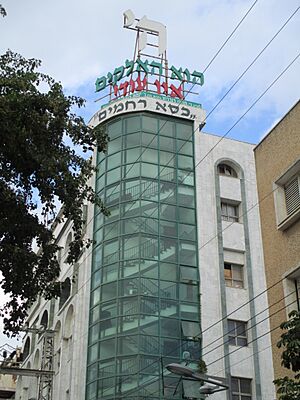
While yeshivas have ancient roots, large-scale Jewish schools were not as common in North Africa and the Middle East for Sephardi Jews in earlier times. Education often happened more informally in synagogues or with famous rabbis. In medieval Spain, some schools combined Jewish studies with sciences. In 19th-century Jerusalem, a "college" was often a place that supported ten scholars rather than a modern school. Early formal yeshivas for Sephardi Jews, similar to European ones, were Midrash Bet Zilkha (1870s Iraq) and Porat Yosef Yeshiva (1914 Jerusalem). The Bet El yeshiva, founded in 1737 in Jerusalem, was for advanced study of Kabbalah (Jewish mysticism).
Sephardi Jewish communities traditionally gave a more central role to the study of Kabbalah than European Ashkenazi communities. After Jewish communities from Arab and Muslim countries moved to Israel, some Sephardi yeshivas started including more accessible Kabbalistic texts in their lessons.
From the 19th Century to Today
Conservative Movement

In 1854, the Jewish Theological Seminary of Breslau was founded. It was the first school linked to "positive-historical Judaism," which led to Conservative Judaism. Later, Conservative Judaism started other higher learning institutions, like the Jewish Theological Seminary of America in New York City. Many of these schools don't call themselves "yeshivas," but they teach in a similar style. They are open to both men and women, who study together. Students can study full-time or part-time, either for the sake of learning or to become rabbis.
Non-Denominational or Mixed Yeshivas
More recently, some new types of seminaries have been created that are not tied to one specific Jewish movement. These schools, like Yeshivat Hadar in New York, train rabbis and leaders with a modified curriculum that often focuses on leadership and community roles.
Reform and Reconstructionist Seminaries
Hebrew Union College (HUC), connected to Reform Judaism, was founded in 1875. It trains rabbis and other clergy. Similarly, the Reconstructionist Rabbinical College (founded 1968) trains its future clergy. These institutions do not call themselves "yeshivas."
Modern Orthodox Yeshivas
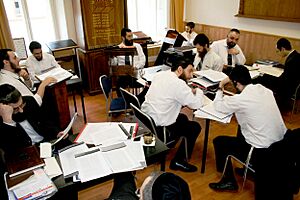
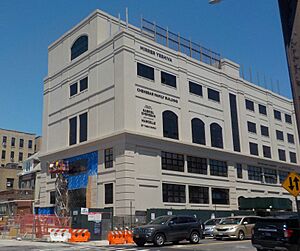
World War II and the Holocaust destroyed many yeshivas in Europe. However, many scholars and students who survived rebuilt yeshivas in Israel and Western countries. For example, the Mir Yeshiva continued to operate in Shanghai during the war and was re-established in Jerusalem in 1944, becoming one of the largest yeshivas in the world.
Today, most yeshivas are in Israel and the U.S., but they are also found in many other countries. The Chabad movement, for instance, established a network of yeshivas called Tomchei Temimim around the world.
In Israel, yeshivas have existed since ancient times. Many new ones were founded in the early 20th century, and even more were re-established after World War II by survivors. The Haredi community in Israel has grown, and many young men continue their Torah studies in yeshiva until they get married, and then many continue in a kollel.
The Religious-Zionist community has important yeshivas like Mercaz Harav. Many students in this community attend a Hesder yeshiva, which combines Torah study with military service. Women in this community study in midrashot.
In the United States, the first Orthodox yeshiva was Etz Chaim in New York (1886), which later became Yeshiva University. Many Hasidic groups also have their main yeshivas in America. Beth Medrash Govoha in Lakewood, New Jersey, is one of the largest yeshivas outside Israel, with thousands of students.
Modern Orthodox students often spend a year or two in a yeshiva or Midrasha in Israel after high school. Many then attend Yeshiva University, where they combine academic education with Torah study.
How Yeshivas Are Organized
Yeshiva study is different from regular university study in several ways. The year is divided into "zmanim" (terms), and the day is structured into "seders" (study sessions). Learning happens through "shiur" (lectures) and "chavruta" (paired study). This paired study usually takes place in a large study hall called a bet midrash.
The head of a yeshiva is called the rosh yeshiva. Other senior rabbis are called "Ram." A mashgiach helps students with their spiritual growth. A sho'el u'meishiv is available to help students with difficult questions in their Talmud studies. Students are called talmidim.
The Academic Year
The yeshiva year has three main terms called zmanim:
- Elul zman: About six weeks long, from the start of the Hebrew month of Elul until the end of Yom Kippur. It's a very intense study period before the High Holidays.
- Winter zman: About five months long, from after Sukkot until two weeks before Passover.
- Summer zman: About three months long, from after Passover until Rosh Chodesh Av or Tisha B'Av.
Chavruta-Style Learning
Chavruta learning is a key part of yeshiva life. Students prepare for and review classes with their study partner during a seder. Instead of just listening to a teacher, students analyze the material themselves, explain it to their partner, and challenge each other's ideas. This helps them think critically, express their thoughts, and understand different viewpoints.
Chavruta learning can be very lively! Partners often read texts aloud, discuss, debate, and even argue to understand the material. In a large yeshiva, you might hear dozens or hundreds of pairs discussing at once. Students learn to focus on their own discussion despite the noise.
Types of Yeshivas
Here are some common types of yeshivas:
- Yeshiva Ketana or Talmud Torah: These are for younger students. Some focus only on Jewish studies, while others include secular subjects.
- Yeshiva High School (also called Mesivta or Yeshiva Tichonit in Israel): These schools combine intensive Jewish religious education with a regular high school education.
- Mechina: For Israeli high school graduates who want to study for a year before joining the army.
- Beth Midrash: For high school graduates, where students can study for one year or many years, depending on their plans.
- Yeshivat Hesder: These Israeli yeshivas have a special arrangement with the Israel Defense Forces. Students enlist together and serve in the army for a period (about 16 months over 5 years), spending the rest of the time in compulsory study at the yeshiva.
- Kollel: A yeshiva for married men who want to continue their Torah studies full-time.
- Baal Teshuva Yeshivot: These schools are for people who are newly becoming Orthodox and need a special program to learn about Jewish life.
For women, post-high school institutions are usually called "seminaries" or midrasha (in Israel). These schools provide a Torah education, often focusing on practical Jewish law and the Tanakh (Hebrew Bible). Some midrashot also include study of Talmud and Jewish philosophy.
Languages Used
In most Lithuanian and Hasidic yeshivas around the world, classes are taught in Yiddish. However, some, like Kol Torah in Jerusalem, teach in Hebrew. Sephardi, Modern Orthodox, and baal teshuvah yeshivas use Modern Hebrew or the local language (like English in America). Students usually study with each other in the language they know best.
College Credit
Some yeshivas allow students to attend college at the same time. Often, students can get college credit for their yeshiva studies. For example, Yeshiva University in New York gives a year's worth of credit for yeshiva studies. Some American yeshivas even offer degrees like a Bachelor of Talmudic Law or Master of Rabbinic Studies. These degrees are recognized and can help students go on to graduate school.
Non-Orthodox institutions usually require students to earn a master's degree as part of their rabbinical training.
What Students Learn
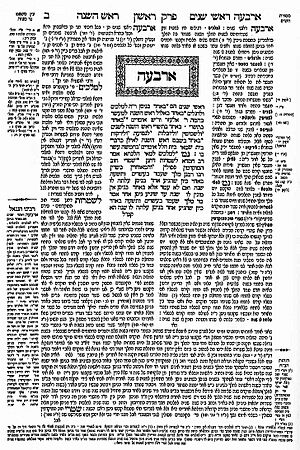
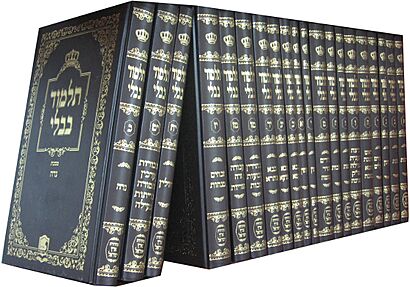
In an Orthodox yeshiva, the main focus is on studying rabbinic literature, especially the Talmud and Jewish law (halacha). They also often study Mussar (ethics) and Hasidic philosophy. Some schools also formally study classical Jewish philosophy or Kabbalah (Jewish mysticism).
Non-Orthodox schools combine traditional and modern ways of studying. Their curriculum also includes Jewish subjects like Talmud, Tanakh, and philosophy, but they might give less emphasis to Talmud and Jewish law. They also focus on skills needed for a modern rabbi, like preaching and counseling.
The sections below describe the traditional Orthodox approach to learning.
Studying the Talmud
The main part of learning in an Orthodox yeshiva is studying the Talmud, especially its analytical part, Gemara. This involves deep discussions and debates to understand the cases and teachings in the Mishnah (the core text of the Talmud).
Students usually study two types of Talmud during a term:
- Iyyun: This is in-depth study, focusing on specific legal topics and using analytical skills with classical commentators.
- Beki'ut: This aims to build a general knowledge of the Talmud by covering a lot of material.
Yeshivas for younger students often focus on Talmudic sections about civil law and marriage law. These sections help students learn the right way to analyze the Talmud. Later, they move on to other areas. They often study tractates like Berachot, Sukkah, Pesachim, and Shabbat.
To understand the Talmudic text, students first study the commentaries by Rashi and Tosafot. These are considered essential for further analysis. More advanced students then study other commentators from different periods, who offer deeper analysis and clarify different opinions.
Students also learn to connect the Talmudic discussions to codified Jewish law, especially the Mishneh Torah (by Maimonides) and the Shulchan Aruch (a code of Jewish law). They study how different commentators' opinions relate to practical Jewish life.
As students advance, they integrate more commentaries into their study of a sugya (a unit of Talmudic discussion). This deep study, called iyyun, can take different forms depending on the yeshiva's "way of learning." Some yeshivas use the "Brisker method," which is highly analytical and looks for underlying principles. Others focus more on understanding the simple meaning of the text or how the discussions lead to practical Jewish law.
The Rosh Yeshiva (head of the yeshiva) gives the most advanced class, where students learn the yeshiva's specific approach to in-depth study. The Rosh Yeshiva also gives a weekly "comprehensive lecture" that reviews the week's learning and explores a topic in more detail.
Boys usually start studying the Talmud in elementary school, beginning with the Mishnah. In middle school, they start learning Gemara, and by high school, some can work with Tosafot.
Learning Jewish Law (Halakha)
A part of the daily schedule is usually dedicated to studying practical halakha (Jewish law), focusing on how to apply the laws. For Ashkenazi yeshivas, the most common text is the Mishnah Berurah, a commentary on the Shulchan Aruch. Sephardic yeshivas often study the Shulchan Aruch itself, along with other commentaries like Yalkut Yosef. Chabad yeshivas focus on Shulchan Aruch HaRav. Younger students often review the Kitzur Shulchan Aruch to get a general overview of Jewish law.
Students in Semikha (rabbinical ordination) programs and kollels spend most of their time on halakha. They study in depth the areas where rabbis are usually asked questions, such as Kashrut (kosher laws), Shabbat (Sabbath laws), and Niddah (family purity laws). This study involves a detailed analysis of the halakha from its sources in the Arba'ah Turim and Bet Yosef, through the Shulchan Aruch and its main commentaries, and also includes studying important responsa (rabbinic answers to questions). This deep study is built on a strong knowledge of the relevant Talmudic discussions.
Ethics, Mysticism, and Philosophy
Most Haredi yeshivas (except for Brisker ones) have a study session dedicated to mussar (ethics and character development). A very important text studied is the Mesillat Yesharim ("Path of the Just"). These sessions help students understand themselves, internalize the spiritual goals of Judaism, and develop good character traits.
Hasidic yeshivas study the mystical and spiritual works of Hasidic philosophy (Chassidus). These texts explain Jewish mysticism in a way that helps students feel a deep connection to God and bring a spiritual element into their daily lives. For example, Chabad yeshivas study the Tanya and other Chabad texts every morning and evening.
As mentioned, Sephardi yeshivas often include the study of selected Kabbalistic texts. These texts are also found in halachic works, so students learn about them indirectly as well.
In Hesder, Religious Zionist, and Modern Orthodox yeshivas, Machshavah (Jewish philosophy or "Jewish thought") is taught formally. Classes cover classic topics and modern issues based on important philosophical works. These works draw from Talmudic-Aggadah (narrative parts of the Talmud) and Tanakh. Hesder yeshivas also spend time on the writings of Abraham Isaac Kook, who combined mysticism, interpretation, and philosophy.
Studying Torah and Bible
Intensive study of Chumash (the Torah, the first five books of the Bible) with Rashi's commentary is emphasized in all elementary grades. In Haredi and Hasidic yeshivas, this is often done with Yiddish translations. The rest of the Tanach (the entire Hebrew Bible, including Prophets and Writings) is usually taught through high school, though less intensely.
In yeshivas, older students typically follow the practice of Shnayim mikra ve-echad targum, which means reviewing the upcoming weekly Torah portion twice in Hebrew and once in Targum Onkelos (an Aramaic translation), along with Rashi's commentary. Students might also study Ramban's commentary and other commentaries from the Mikraot Gedolot edition. The Rosh Yeshiva often gives a weekly lecture on the Torah portion, exploring a specific question or theme with an ethical teaching.
In Hesder, Religious Zionist, and Modern Orthodox yeshivas, the study of Chumash and Nach continues alongside Talmud study. These schools offer formal classes in many books of the Prophets and Writings. These classes analyze the text and its structure using various commentaries and Midrashim (ancient Jewish interpretations), often complementing the philosophy classes.
See also
 In Spanish: Yeshivá para niños
In Spanish: Yeshivá para niños
- Bais Yaakov
- Jewish day school
- List of yeshivas
- Mesivta
- Religious school


